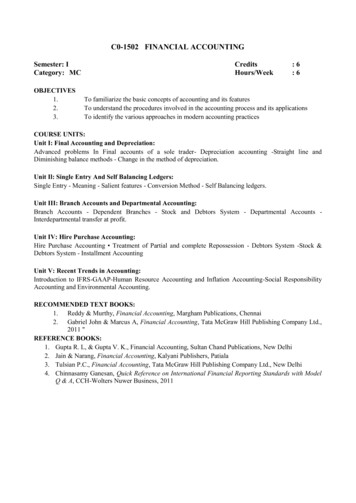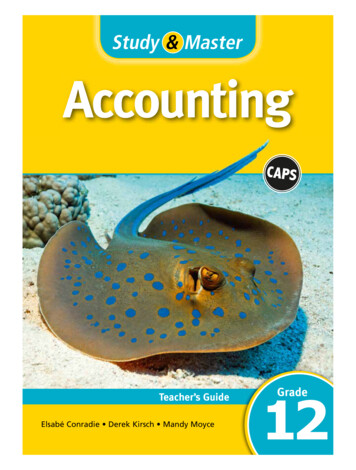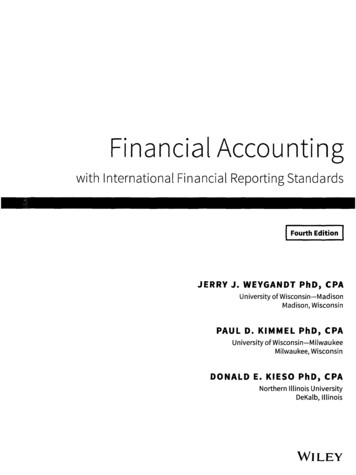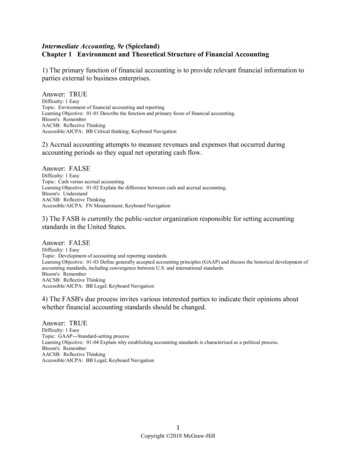
Transcription
STUDYFoundation levelFinancial Accountingand Reporting2014MANUAL
Fifth edition 2014First edition 2010ISBN 9781 4453 6872 6Previous ISBN 9781 4453 6604 3British Library Cataloguing-in-Publication DataA catalogue record for this bookis available from the British Library.Published by BPP Learning Media LtdAll rights reserved. No part of this publication maybe reproduced or transmitted in any form or by anymeans or stored in any retrieval system, electronic,mechanical, photocopying, recording or otherwisewithout the prior permission of the publisher.The contents of this book are intended as a guide andnot professional advice. Although every effort hasbeen made to ensure that the contents of this bookare correct at the time of going to press, BPPLearning Media, the Editor and the Author make nowarranty that the information in this book is accurateor complete and accept no liability for any loss ordamage suffered by any person acting or refrainingfrom acting as a result of the material in this book.Every effort has been made to contact the copyrightholders of any material reproduced within thispublication. If any have been inadvertentlyoverlooked, BPP Learning Media will be pleased tomake the appropriate credits in any subsequentreprints or editions.We are grateful to CPA Australia for permission toreproduce the Learning Objectives, the copyright ofwhich is owned by CPA Australia.Printed in AustraliaThis is printed on FSC accredited stock by an FSCaccredited printer. BPP Learning Media Ltd 2014ii
CPA ProgramThe CPA Program’s foundation levelCPA Australia is a member of the International Federation of Accountants (IFAC). All CPA Programeducation materials are developed in line with IFAC’s International Education Standards. These standardsprovide guidance in establishing the content of professional accounting education programs together withthe associated assessment. The standards also assist in developing the required passing standard foraccounting education and competence of a professional accountant.The foundation level exams provide you with the opportunity to demonstrate your competence in coreknowledge areas required for Associate membership of CPA Australia. By demonstrating this entry levelknowledge you will be well positioned to succeed at the professional level of the CPA Program andultimately attaining the CPA designation.You and your study planThis study manual is designed to give you an understanding of what to expect in your exam as a well ascovering the fundamentals that you need to know. Exams will be based on the contents of this studymanual.There are no specifically recommended hours of study. Each candidate brings their own level of experienceand knowledge to the foundation level units. The number of study hours required is entirely dependent onyour prior knowledge of the subject. You will need to develop your own study plan. Refer to Preparing forfoundation level exams on page viii.Additional Learning SupportIf you feel that you have gaps in your knowledge after reviewing your study manual, there is a range ofoptional additional support to assist in your exam preparation. Additional learning support includes face-toface and online tuition, Passcards and i-Pass CDs to cater for different learning styles and budgets.Please check the CPA Australia website for more information www.cpaustralia.com.au/learningsupportStandards and LegislationThe material in this study manual has been prepared based upon standards and legislation in effect as at1 September 2013. Candidates are advised that they should confirm effective dates of standards andlegislation when using additional study resources. Exams for 2014 are based on the learning objectivesoutlined within this study manual.iii
iv
ContentsPageIntroductionCPA ProgramiiiChapter featuresviPreparing for foundation level examsviiiChapter summaryxLearning objectivesxiiChapter1Financial reporting and the regulatory framework12The conceptual framework and accounting policies153The financial statements414Statement of cash flows675Inventory and property, plant and equipment936Intangible assets1217Impairment of assets1378Taxation1539Accounting for foreign currency17510The principles of consolidation19311The consolidated statement of financial position20712The consolidated statement of profit or loss25113Associates and equity accounting26714Analysis of financial statements287Revision questions325Answers to revision questions351Before you begin questions: Answers and commentary367Glossary of terms389Formulae399Index403Introductionv
Chapter featuresEach chapter contains a number of helpful features to guide you through each topic.Learning objectivesShow the referenced CPA Australia learning objectives.Topic listTells you what you will be studying in this chapter.IntroductionPresents a general idea of what is covered in this chapter.Chapter summarydiagramSummarises the content of the chapter, helping to set the scene so that you canunderstand the bigger picture.Before you beginThis is a small bank of questions to test any pre-existing knowledge that you mayhave of the chapter content. If you get them all correct then you may be able toreduce the time you need to spend on the particular chapter. There is acommentary section at the end of the Study Manual called Before you begin: Answersand commentary.Section overviewThis summarises the key content of the particular section that you are about tostart.Learning objectivereferenceThis box indicates the learning objective covered by the section or paragraph towhich it relates.LO1.2DefinitionDefinitions of important concepts. You really need to know and understand thesebefore the exam.Exam commentsThese highlight points that are likely to be particularly important or relevant tothe exam. (Please note that this feature does not apply in every Foundation Levelstudy manual.)examviWorked exampleThis is an illustration of a particular technique or concept with a solution orexplanation provided.QuestionThis is a question that enables you to practise a technique or test yourunderstanding. You will find the solution at the end of the chapter.Key chapter pointsReview the key areas covered in the chapter.Financial Accounting and Reporting
Quick revisionquestionsA quick test of your knowledge of the main topics in this chapter.RevisionThe revision questions are not a representation of the difficulty or style ofquestions which will be in the exam. They provide you with an opportunity torevise and assess your knowledge of the key concepts covered in the materials sofar. They are not a practice exam, but rather a means to reflect on key conceptsand not as the sole revision for the exam.questionsThe quick revision questions are not a representation of the difficulty or style ofquestions which will be in the exam. They provide you with an opportunity torevise and assess your knowledge of the key concepts covered in the materials sofar. They are not a practice exam, but rather a means to reflect on key conceptsand not as the sole revision for the exam.Case studyThis is a practical example or illustration, usually involving a real world scenario.Formula to learnThese are formulae or equations that you need to learn as you may need to applythem in the exam.Bold textThroughout the Study Manual you will see that some of the text is in bold type.This is to add emphasis and to help you to grasp the key elements within asentence and paragraph.Introductionvii
Preparing for foundation level examsStudy plan Review all the learning objectives thoroughly. Use the topic exam weightings listed at the end of thelearning objectives to develop a study plan to ensure you provide yourself with enough time torevise each learning objective. Don’t leave your study to the last minute. You may need more time to explore learning objectives ingreater detail than initially expected. Be confident that you understand each learning objective. If you find that you are still unsure afterreading the study manual, seek additional information from other resources such as text books,supplementary learning materials or tuition providers.Study techniques In addition to being able to complete the revision and self-assessment questions in the study manual,ensure you can apply the concepts of the learning objectives rather than just memorising responses. Some units have formulae and discount tables available to candidates throughout the exams. MyOnline Learning lists the tools available for each unit under "Useful Resources". Check My Online Learning on a weekly basis to keep track of announcements or updates to thestudy manual. Familiarise yourself with the exam environment by downloading the exam software tutorial and learnhow to navigate your way around the exam software quickly on the Pearson VUE website.www.pearsonvue.com/athenaTips for examsviii Plan to arrive at the exam centre at least 15 minutes before your exam. Allow for possible delayswith public transport or traffic. You have three hours and fifteen minutes to complete the exam. As soon as you commence theexam your exam clock in the top right hand corner of the screen begins to count down. Watch yourtime carefully.Financial Accounting and Reporting
Answering multiple choice questionsFoundation level exams are a series of 100 multiple choice questions. Each question will contain fourpossible options.Step 1Attempt every question. Read the question thoroughly. You may prefer to work out theanswer before looking at the options, or you may prefer to look at the options at thebeginning. Adopt the method that works best for you.Step 2Read the four options and see if one matches your own answer. Be careful with numericalquestions, as some options are designed to match answers that incorporate common errors.Check that your calculation is correct. Have you followed the requirement exactly? Have youincluded every step of the calculation?Step 3You may find that none of the options matches your answer.Step 4 Re-read the question to ensure that you understand it and are answering therequirement. Eliminate any obviously wrong answers. Consider which of the remaining answers is the most likely to be correct and selectthe option.If you are still unsure, make a note and continue to the next question. Some questions willtake you longer to answer than others. Try to reduce the average time per question, to allowyourself to revisit problem questions at the end of the exam.Revisit unanswered questions. When you come back to a question after a break you oftenfind you are able to answer it correctly straight away. You are not penalised for incorrectanswers, so never leave a question unanswered!Introductionix
Chapter summaryThis summary provides a snapshot of each of the chapters, to help you to put the syllabus as a whole andthe Study Manual itself into perspective.Chapter 1 – Financial reporting and the regulatory frameworkIn this introductory chapter we will consider the purpose of financial reporting and in particular who thefinancial statements are prepared for – the users of financial statements – and their information needs. Wewill also consider the regulatory framework within which international accounting standards are preparedand how this contributes to international GAAP.Chapter 2 – The conceptual framework and accounting policiesThe IASB's Conceptual Framework for Financial Reporting represents the conceptual framework on which allIFRSs are based and in this chapter we will consider this in detail. Allied to the conceptual framework isIAS 8 Accounting policies, changes in accounting estimates and errors, which should be considered when anentity decides upon its accounting policies.Chapter 3 – The financial statementsFor the purpose of this syllabus we will be studying how to prepare a set of financial statements for limitedliability companies, either single companies or groups of companies.In this chapter we begin by looking at the overall format and content of company financial statements as setout in IAS 1 (revised) Presentation of financial statements. This Chapter also covers IAS 18 Revenue, whichprovides guidance on the recognition and measurement of income within profit or loss in the statement ofprofit or loss and other comprehensive income.Chapter 4 – Statement of cash flowsAs well as a statement of financial position and a statement of profit or loss and other comprehensiveincome, a company must also prepare a statement of cash flows. In this chapter we shall consider in detailIAS 7 Statement of cash flows and how to prepare such a statement.Chapter 5 – Inventory and property, plant and equipmentIn this chapter we consider two important elements of financial statements – inventory and non-currentassets. The valuation of inventory has a direct impact on gross profit and therefore is an important area.Property, plant and equipment is often the biggest balance in many companies’ statement of financialposition. We will consider how to account for the initial cost of non-current assets, how to depreciatethose assets, how to revalue assets if desired and how to account for the disposal of any non-currentassets.Chapter 6 – Intangible assetsIn the previous chapter we considered the accounting treatment of tangible non-current assets. In thischapter we move on to study the accounting treatment of intangible non-current assets in general andresearch and development costs in particular.xFinancial Accounting and Reporting
Chapter 7 – Impairment of assetsCarrying on from the previous two chapters we now consider the accounting treatment when an asset,either tangible or intangible, falls in value. The accounting requirements are set out in IAS 36 Impairment ofassets and include consideration of cash-generating units.Chapter 8 – TaxationThis chapter deals with the two main aspects of taxation in a limited company’s financial statements whichare current tax and deferred tax.Chapter 9 – Accounting for foreign currencyThere are two main aspects to dealing with foreign exchange which will be dealt with in this chapter. Firstly,many companies will buy or sell goods from or to another country and in a foreign currency. Thesetransactions in the foreign currency must be translated before they can be included in the financial records.The second aspect is that groups may include a foreign subsidiary and before the subsidiary’s results can beincluded in the group financial statements the subsidiary’s own financial statements must be translated.Chapter 10 – The principles of consolidationThe next four chapters will be looking at the techniques for preparing group financial statements orconsolidated financial statements. In this introductory chapter we will consider the major definitions andprinciples of consolidation which are vital to your understanding of the subject.Chapter 11 – The consolidated statement of financial positionIn this chapter we will study the basic procedures for producing a consolidated statement of financialposition. Plenty of question practice is required but if you understand the basic steps and workings at thisstage then your further studies of consolidated financial statements will become much easier.Chapter 12 – The consolidated statement of profit or lossThis chapter covers the preparation of the consolidated statement of profit or loss. If you understood theprevious chapter then most of the consolidation adjustments for a consolidated statement of profit or lossshould be fairly straightforward.Chapter 13 – Associates and equity accountingWe have seen how to deal with subsidiaries in the consolidated financial statements in the last few chaptersbut in this chapter we will consider the accounting treatment of associated companies. This is known as theequity method of accounting.Chapter 14 – Analysis of financial statementsIn this chapter we consider the interpretation of financial statements by looking at the calculation of anumber of different ratios and more importantly how these ratios can be used to analyse and interpret thefinancial statements. We shall also consider the limitations of financial analysis.Introductionxi
Learning objectivesCPA Australia's learning objectives for this Study Manual are set out below. They are cross-referenced tothe chapter in the Study Manual where they are covered.Financial Accounting and ReportingGeneral overviewThis exam covers an understanding of the format and function of financial statements, including analysis andinterpretation of financial statements. It also includes the production of financial statements for consolidatedcompany groups, and foreign currency translation.These are the topics that will be covered in the exam.TopicsChapter(s)where coveredLO1. Financial reporting and the regulatory frameworkLO1.1Explain the meaning of generally accepted accounting principles andidentify the key elements of the IASB Conceptual Framework for FinancialReporting and its relationship to accounting standards1,2LO1.2Explain the objectives of financial reporting and general purpose financialreports1LO1.3Analyse the qualitative characteristics of accounting information2LO1.4Analyse and apply the criteria for identifying a reporting entity1LO2. Statement of profit or loss and other comprehensive incomeLO2.1Explain and apply the provisions of IAS 1 Presentation of FinancialStatements for the determination of profit (loss) of an entity3LO2.2Apply the provisions of IAS 1 for disclosures to be made in a statement ofprofit or loss and other comprehensive income; statement of changes inequity; and statement of financial positionLO2.3Analyse and apply the guidelines for the selection of accounting policiesand the disclosures required about changes in accounting policies(IAS 8 Accounting policies, changes in accounting estimates and errors)2LO2.4Apply the requirements of IAS 12 Income taxes and prepare associatedjournal entries83, 5, 6, 7LO3. Statement of financial positionLO3.1xiiApply the provisions of IAS 1 for disclosures to be made in a statement ofprofit or loss and other comprehensive income; statement of changes inequity; statement of financial positionFinancial Accounting and Reporting3, 5, 6, 7
Chapter(s)where coveredLO3.2Analyse and apply the guidelines for the selection of accounting policiesand the disclosures required about changes in accounting policies(IAS 8 Accounting policies, changes in accounting estimates and errors)2LO3.3Apply the requirements of IAS 12 Income taxes and prepare associatedjournal entries8LO4. Statements of cash flowLO4.1Explain the usefulness of the statement of cash flow4LO4.2Explain and apply the definition of cash and cash equivalents4LO4.3Describe the differences between operating, investing and financingactivities4LO4.4Prepare a statement of cash flow using the direct and indirect methods4LO4.5Outline disclosure requirements of IAS 74LO5. Ratio analysis and interpretation of financial statementsLO5.1Prepare a comparative analysis of financial statements14LO5.2Identify and apply the tools of financial statement analysis14LO5.3Identify and calculate ratios, describe their purpose and use in analysingan entity’s liquidity, profitability and solvency14LO5.4Explain ratio interrelationships14LO5.5Analyse and interpret a set of financial statements using ratios14LO5.6Explain the limitations of financial statement analysis14LO6. Consolidated financial statementsLO6.1Discuss the forms of business combinations10LO6.2Explain how goodwill is measured and disclosed at date of acquisition11LO6.3Explain how goodwill is measured subsequent to the date of acquisitionincluding the requirements regarding impairment11LO6.4Explain the concept of control and how the existence of control isdetermined10LO6.5Explain and prepare consolidation worksheet entries where a parent hasan ownership interest in a subsidiaryLO6.6Explain why transactions within a group must be eliminatedLO6.7Explain when profit from transactions within a group will be consideredto be realised11LO6.8Prepare consolidation worksheet entries to eliminate transactions withina group11, 12LO6.9Define and explain the concept of ‘non-controlling interest’11, 1211, 1210, 11, 12LO7. Equity accountingLO7.1Define ‘significant influence’ and briefly analyse the factors that may beused to determine whether significant influence exists10LO7.2Explain the underlying methodology of the equity method and outline itsbasic features13Introductionxiii
Chapter(s)where coveredLO7.3Calculate the investor’s share in an investee and explain why this conceptis important13LO7.4Prepare journal entries to account for the initial application of the equitymethod13LO7.5Prepare equity accounting entries to record investee results anddividends13LO7.6Outline the disclosure requirements for investments in associates (IFRS 12)13LO8. Accounting for foreign currencyLO8.1Explain and account for foreign currency transactions at transaction dateand subsequent dates9LO8.2Apply the requirements of IAS 21 to record foreign currencydenominated transactions and exchange rate differences that arise onforeign currency monetary items9LO8.3Explain and apply the IAS 21 method for translating financial statementsfrom a functional currency to a presentation currency9LO8.4Outline the disclosure requirements of IAS 219Weighting of learning objective in exam1Financial reporting and the regulatory framework15%2Statement of profit or loss and other comprehensive income10%3Statement of financial position10%4Statements of cash flow10%5Ratio analysis and interpretation of financial statements20%6Consolidated financial statements25%7Equity accounting5%8Accounting for foreign currency5%TOTALxivFinancial Accounting and Reporting100%
Chapter 1Financial reporting andthe regulatory frameworkLearning objectivesReferenceFinancial reporting and the regulatory frameworkLO1Explain the meaning of generally accepted accounting principles and identify thekey elements of the IASB Conceptual Framework for Financial Reporting and itsrelationship to accounting standardsLO1.1Explain the objectives of financial reporting and general purpose financialreportsLO1.2Analyse and apply the criteria for identifying a reporting entityLO1.4Topic list12345The purpose of financial reportingThe reporting entityUsers' and stakeholders' needsThe regulatory framework and accounting standardsInternational GAAP1
IntroductionBefore you learn how to prepare financial reports, it is important to understand why they are prepared.Sections 1 – 3 of this chapter introduce some basic ideas about financial reports and give an indication oftheir purpose, including consideration of the main users of financial statements and their needs.In Sections 4 and 5, we introduce the regulatory system run by the International Accounting StandardsBoard (IASB), and how the Standards it produces contribute to International GAAP.The chapter content is summarised in the diagram below.Financial reporting andthe regulatory frameworkReporting entity:Entity whose generalpurpose financialstatements are reliedupon by users ofaccountsTo record, analyse andsummarise a reporting entity’sfinancial data to satisfy theneeds of users of the accountsSupportsA regulatory framework andaccounting standards help makefinancial statements moreuseful to usersIASB issues Standards2Financial Accounting and ReportingUsers have differentneeds:- Management- Shareholders- Suppliers- Customers- Lenders- Authorities- Employees- Financial analysts andadvisers- PublicThe IFRS Interpretations Committeeand IASB issue Interpretations
CHAPTERBefore you beginIf you have studied these topics before, you may wonder whether you need to study this chapter in full. Ifthis is the case, please attempt the questions below, which cover some of the key subjects in the area.If you answer all these questions successfully, you probably have a reasonably detailed knowledge of thesubject matter, but you should still skim through the chapter to ensure that you are familiar with everythingcovered.1There are references in brackets indicating where in the chapter you can find the information, and you willalso find a commentary at the back of the Study Manual.1What is the purpose of financial reporting?(Section 1)2What is a reporting entity?(Section 2)3Who are the main user groups of financial statements, and why are they interested in financialinformation?(Sections 3.1 and 3.2)4Which four international bodies are involved in the regulation of accounts and financial reporting?(Section 4)5What is the purpose of each of these bodies?(Section 4)6What is GAAP?(Section 5)1: Financial reporting and the regulatory framework3
1 The purpose of financial reportingSection overview Financial reporting is the process of classifying, recording and presenting financial data inaccordance with generally established concepts and principles.Financial data is the name given to the actual transactions carried out by a business e.g. sales of goods,purchases of goods, payment of expenses. These transactions are analysed according to type, recorded inledger accounts and summarised in the financial statements.Financial reporting is therefore the process of reporting the results and financial position of a business or'reporting entity'. It is not primarily concerned with providing information towards the more efficientrunning of the business. Although financial accounts are of interest to management, their principal functionis to provide historical information in order to satisfy the information needs of persons not involved inrunning the business.Question 1: Financial reportingFinancial reporting means the financial statements produced only by a large listed company.Is this statement correct?ABYesNo(The answer is at the end of the chapter)2 The reporting entitySection overview LO1.4A reporting entity is an entity whose general purpose financial statements are relied upon byother parties, or users of the accounts.A reporting entity is defined in Australia as 'an entity in respect of which it is reasonable to expect theexistence of users who rely on the entity's general purpose financial statements for information that will beuseful to them for making and evaluating decisions about the allocation of resources. A reporting entity canbe a single entity or a group comprising a parent and all of its subsidiaries'.The 'reporting entity' concept is not, however, one that is currently adopted outside Australia and atpresent International standard-setters have no official equivalent definition. Internationally therefore, areporting entity is taken quite simply to be an entity, or group of entities, which prepare accounts. Aproject is currently underway to develop an international 'reporting entity' concept.4Financial Accounting and Reporting
3 Users' and stakeholders' needs3.1CHAPTERThe need for financial statementsSection overview There are various groups of people who need information about the activities of a reporting entity.1LO1.2Why do businesses need to produce financial statements? If a business is being run efficiently, why should ithave to go through all the bother of accounting procedures in order to produce financial information?The International Accounting Standards Board states in its document The Conceptual Framework for FinancialReporting (The Conceptual Framework) which we will examine in detail later in this Study Manual:'The objective of general purpose financial reporting is to provide financial information about thereporting entity that is useful to existing and potential investors, lenders and other creditors inmaking decisions about providing resources to the entity. Those decisions involve buying, selling orholding equity and debt instruments, and providing or settling loans and other forms of credit.'In other words, a business should produce information about its activities because there are particulargroups of people who want or need to know that information. This sounds rather vague: to make it clearer,we will study the classes of people who need information about a business. We need also to think aboutwhat information in particular is of interest to the members of each class.Large businesses are of interest to a greater variety of people and so we will consider the case of a largepublic company, whose shares can be purchased and sold on a stock exchange. The Conceptual Frameworkspecifically mentions investors and lenders, but in practice these may not be the only users.3.2Users of financial statements and accounting informationThe following primary users are likely to be interested in financial information about a large company withlisted shares:(a)Shareholders of the company, i.e. the company's owners, want to assess how well themanagement is performing. They want to know how profitable the company's operations are andhow much profit they can afford to withdraw from the business for their own use.(b)Providers of finance to the company might include a bank which allows the company to operatean overdraft, or provides longer-term finance by granting a loan. The bank wants to ensure that thecompany is able to meet interest payments, and eventually to repay the amounts advanced.(c)Trade contacts include suppliers who provide goods to the company on credit and customers whopurchase the goods or services provided by the company. Suppliers want to know about the company'sability to pay its debts; customers need to know that the company is a secure source of supply and is inno danger of having to close down.Other users of financial statements include:(d)Managers of the company appointed by the company's owners to supervise the day-to-dayactivities of the company. They need information about the company's financial situation as it iscurrently and as it is expected to be in the future. This is to enable them to manage the businessefficiently and to make effective decisions.(e)The taxation authorities want to know about business profit
x Financial Accounting and Reporting Chapter summary This summary provides a snapshot of each of the chapters, to help you to put the syllabus as a whole and the Study Manual itself into perspective. Chapter 1 –











